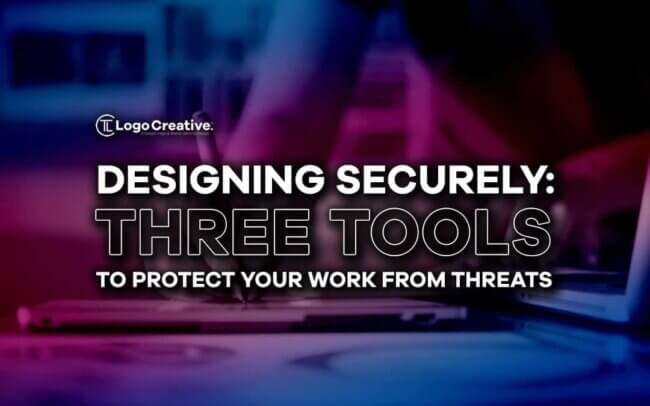The graphic design profession is among the most affected by Internet technologies. In this article we look at Designing Securely: Three Tools to Protect Your Work from Threats.
Every new design software opens up new possibilities and challenges for graphic designers. On top of that, the rapid expansion of e-commerce platforms skyrocketed the demand for visual content.
Currently, about 90% of graphic designers work as freelancers. They can easily perform their tasks remotely, and many choose to work with more than one client to increase their salaries. However, working outside of the company’s environment poses specific risks, intellectual property theft being one of them.
If you are worried about your online creative material safety or have become a victim of IP theft in the past, continue reading to learn a few easy tricks for protecting your online valuables.
Table of Contents
The Types of Intellectual Property
Firstly, let’s overview the four types of intellectual property. Knowing which type you produce will help you understand different laws regulating its protection. Because IP theft is a crime, you can contact law enforcement and file a lawsuit against the attacker.
- Trademarks. This category is where most graphic design content fits. Trademarks are symbols, designs, words, phrases, or a combination, that defines and separates a specific creation from others. They also include specific colors, slogans, logo design, and images. The United States Patent and Trademark Office regulates these creative goods in the US.
- Copyrighted material. They include paintings, books, articles, and software. Graphic designers can also copyright their material to protect it from being used without their consent. Businesses most often copyright their exclusive logos and design layouts.
- Patents. A patent binds inventions to people who developed them. Using another person’s patent material is prohibited, but criminals often try to modify the creation with minor tweaks and pass it as theirs. The same office regulates it as trademarks in the US.
- Trade secrets. They are especially important because trade secrets are a major business competitive advantage. As a graphic designer working for companies, you may be trusted with specific design-related trade secrets that form the company’s brand, and protecting this information is of utmost importance.
Hacking as a Threat to Designers’ Creative Goods
Currently, most graphic design tasks are done with computers. As comfortable and innovative as this technology is, it is ridden with cybercrime. If you are dealing with confidential business information as a freelance graphic designer, it is your responsibility to protect it.
Here are the most common IP theft hacking methods and tips on defending against them.
Phishing
Phishing is a social engineering and hacking technique that heavily relies on human error. Most often, it is done via email. However, it can also happen on the phone (vishing), online forums, or via text messages.
Hackers attempt to extract valuable information, like passwords, or infect the user’s device with malware. They achieve that by forging convincing fraudulent emails with infectious backlinks or attachments. When you download such an attachment, spyware might infect your device, monitoring your activities and stealing your creative work.
Reliable antivirus and phishing knowledge are the first lines of defense. You should always carefully inspect the email and verify the sender’s address. You can contact them directly for verification if the email claims to come from a specific business. You can check this informative LinkedIn post by an experienced graphic designer to learn more. Meanwhile, an AntiVirus will protect you if you mistakenly download an infected attachment.
Credential Dumping
As a graphic designer, you most likely use several password-protected tools. More so, with the rise of Cloud services, many designers store their creative work on the Cloud, which they can access from any device with an Internet connection. It’s incredibly comfortable.
However, cybercriminals are very aware of this and use the credential dumping hacking method to target hundreds of different online accounts simultaneously. First, they may try the most popular passwords, such as “qwerty” and “password123”, called brute forcing. Using such passwords is very risky. They will use passwords obtained from dozens of vast yearly data leaks if brute forcing does not work.
Instead, you can secure Intellectual Property using a professional password manager. It’s an easy-to-use software that stores all your passwords in an encrypted vault and auto-fills them on demand. You don’t have to remember passwords by heart to use a strong and complex password for each business-related online account.
Public Wi-Fi Safety
Hackers often target public Wi-Fi networks with man-in-the-middle attacks to monitor user activities. It’s vital for freelance graphic designers that frequently use public Wi-Fi to work from their favorite cafes or libraries. If a cybercriminal monitors your Wi-Fi hotspot, they can steal your IP if you try to upload it to a cloud or share it with a client.
Using a Virtual Private Network whenever you work over public Wi-Fi is advisable. This software will apply additional encryption and reroute your data flow through a secure server, protecting it from unwanted attention.
Final Words
It’s best to contact law enforcement if you become a victim of an Intellectual Property Theft, but it’s even better to protect yourself before anything terrible happens. Our three discussed software is an affordable and straightforward way to protect your digital life, especially if you work as a freelancer and can’t rely on workplace network security.
Join The Logo Community
We hope this article about Designing Securely: Three Tools to Protect Your Work from Threats has been helpful. If you would like more personal tips, advice, insights, and access to our community threads and other goodies, join me in our community. You can comment directly on posts and have a discussion.
*TIP – We use and recommend DesignCuts for all your fonts, mockups and design bundles.


